Trade and Industry
Inventory of John Walker of Durham City, alderman
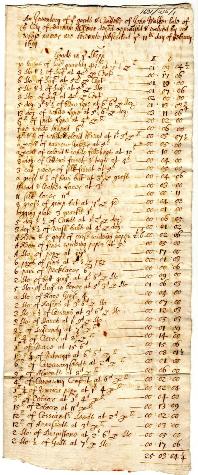
Durham shops offered produce from around the world. This is the first page of the 1692 inventory of Walker's goods which totalled £111 3s 3d. Produce and merchandise listed include items from Europe, Asia and the Americas, and some of which were probably produced using African slave labour: sugar, ferret-silk, Jamaica pepper, ginger, raisins, cloves, mace and tobacco.Most of these goods would have been imported through Newcastle. The north east's investment and involvement in the slave trade economy might also be indicated by this seal of an African head on the 1695 will of a Durham bookseller and bookbinder.
Ref: DPRI/1/1691/W5/1.
Will of Ralph Gilroy esquire of Berwick-upon-Tweed
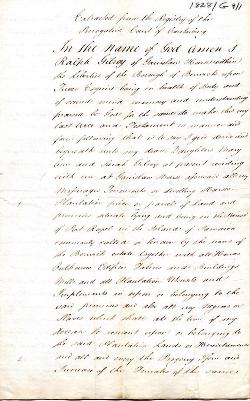
The testator had formerly been resident in Jamaica, and bequeaths his Berwick Estate, a coffee plantation in Port Royal parish, Jamaica, to his legitimate daughters; three other illegitimate daughters are named then living in the United Kingdom. Among his assets Gilroy lists 'all my Negroes or Slaves' resident upon the plantation 'and all and every the Progeny Issue and Increase of the Females of the same', proceeding then to itemise his cattle. The Slavery Abolition Act (1833) redesignated all these slaves aged six and over as apprentices, from which apprenticeships they obtained their release in 1838. However, any issue of his female slaves born after 2 August 1828 would have qualified for immediate emancipation on 1 August 1834 when the Act came into force. A John Gilroy, probably Ralph's brother, is listed in the 1840 Jamaica Almanac as the proprietor of a 467 acre estate of the same name. The will, of which this is a copy, was first proved at London in 1826 and then again at Durham in 1828.
Ref: DPRI/1/1828/G9/1.
Administration bond for the estate of Sarah Jarrett of Blackett Street, Newcastle upon Tyne, widow
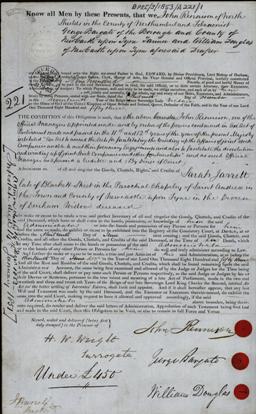
Jarrett was an unlucky shareholder in the Newcastle Shields and Sunderland Union Joint Stock Banking Company which failed in October 1847, its business being picked up by Woods & Company, later absorbed into Barclays. The business having been dissolved, administration was granted to the official managers winding up the company, there being no limit at this time to Jarrett's or the other share holders' liability. The first County Durham bank was founded in 1774 by the Quaker family the Backhouses of Darlington, while The Old Bank of Newcastle was founded in 1755 by Ralph Carr, a merchant who carried on much trade in the Baltic region. Such country banks, when they survived the periodic crises of confidence, played an important role in facilitating trade and supporting the growth of the mining, shipping and textile industries and later the development of the railway network.
Ref: DPRI/3/1853/A221.
Inventory of Henry Milbourne gentleman of Newcastle upon Tyne, hoastman
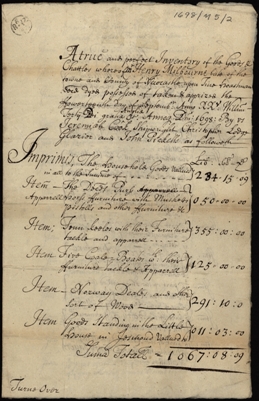
The hoastmen of Newcastle together formed the most powerful mercantile corporation of the city. They achieved this dominance by monopolising the production and export of coal from the port of Newcastle. Milbourne's inventory lists 10 keels, 5 coal boats and shares of 34 other ships of Newcastle, King's Lynn, Hull, Sunderland and elsewhere. Milbourne and his wife both died in 1698, leaving ten children: the curators appointed as their guardians signed a £10,000 bond in 1702, indicating a personal estate of about £5,000 in value.
Ref: DPRI/1/1698/M5/2-3.
Will of Henderson Moore of High Heworth, coal miner
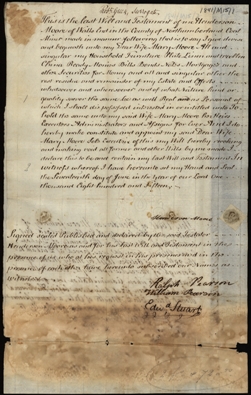
Unusually, Henderson Moore made his will some twenty-six years before his death, and it remained unaltered until his death. He nominates his wife as his universal legatrix and sole executrix. Moore would have worked at the Wallsend and then the High Heworth collieries. He may have been lucky to have survived the 1835 Wallsend pit disaster, but among the 102 names of the men and boys killed in the gas explosion are James Moore, aged 12, and Thomas Moore, aged 14.
Ref: DPRI/1/1841/M15/1-2.
Will of Thomas Burn of Southwick, glass manufacturer

Burn owned six 20th shares in the Crown Glass House at Southwick. His son William Burn was the Secretary of the Sunderland Society for the Prevention of Accidents, working with its founder Dr William Clanny. Clanny developed the safety lamp which was successfully tested at Herrington Mill Pit in the winter of 1815. At this time most of the glass manufactured in the United Kingdom was being produced in Wearside and Tyneside factories, and today the National Glass Centre is located in Sunderland.
Ref: DPRI/1/1815/B17/1-2.
Inventory of Bremen debts of Stephen Maddison of Newcastle upon Tyne, merchant
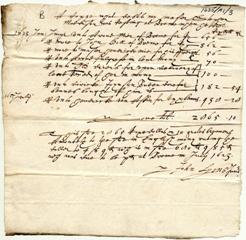
Newcastle merchants and merchant adventurers had extensive trading interests in the British Isles and across Europe, and particularly in the Baltic or Eastland. The probate account entered by Maddison's widow refers to this inventory of debts that her husband was owing in Bremen as having come to her attention only when she had fully administered his estate, and which bill she was 'forced to pay'. The debts date from January to July 1623 and include accounts for rye and beans, unspecified freight, a money debt and also a sum already paid to Maddison or his agent for a quantity of lead, presumeably to be extracted from the North Pennines lead field. The sums were listed by a John Lyons who was perhaps Maddison's apprentice. The total of debts is $2,865 and 10 groats (or groschen) in the local currency rix-dollars or Reichsthaler, and which Lyons calculates to be £680 9s 5d at an exchange rate of 4s 9d to the dollar. At this time the Hanseatic city of Bremen was being drawn into the Thirty Years' War.
Ref: DPRI/1/1625/M1/3.


